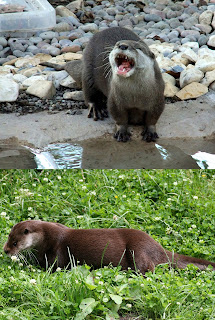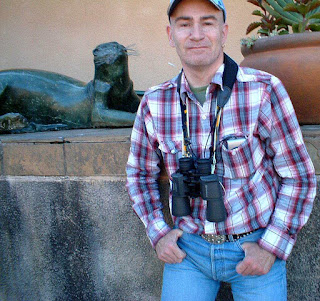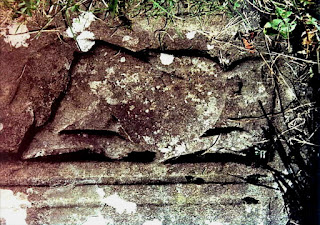At no more than 39 in long in total length, the Asian small-clawed otter Aonyx (=Amblyonx) cinereus is the world’s smallest species of living otter. As a result of how commonly it is exhibited in British zoos, however, it is possibly the most familiar one to many people here – more so, in fact, than our own larger native species, the Eurasian otter Lutra lutra, up to 4 ft long on average (and confirmed maximum length of 4.5 ft), due to the latter’s famous elusiveness.
If we turn from zoos and mainstream zoology to the sequestered realm of cryptozoology, however, its archives of eyewitness reports and folkloric traditions indicate that an even bigger and far more formidable otter might also be encountered in the British Isles. This little-known but thoroughly fascinating mystery beast, known as the dobhar-chú and investigated by me for over 20 years now, is the subject of this present two-part Shukerature article, which as far as I am aware is the most detailed documentation of it ever published.
The dobhar-chú is a supposedly mythical beast from northwestern and western Ireland, is also called the dobarcu, master otter, and king otter, and was classed by English folklorist Dr Katharine Briggs as a prototype animal representing all of its kind there. For Ireland is indeed home to the afore-mentioned Eurasian otter, where it is referred to as the Irish otter, exists at this species’ greatest population density anywhere in Europe, and was once deemed to be a separate species in its own right. In The Anatomy of Puck (1959), Briggs termed the dobhar-chú the master otter, and it was evidently larger than normal otters because she stated that it was said to have appeared once at Dhu-Hill, with “…about a hundred common-sized otters” in attendance. According to legend, an inch of the master otter’s pelt will prevent a ship from being wrecked, a horse from injury, and a man from being wounded by gunshot or other means.
In Myth, Legend and Romance. An Encyclopaedia of the Irish Folk Tradition (1990), Dr Dáithí ó hÓgáin described it as a large male otter called the king otter, reiterating much of the information presented by Briggs but also noting that it was totally white in colour except for its black ear tips and a black cross upon its back, and that it never slept. Yielding an unexpected parallel with the werewolf legend, this uncanny creature could only be killed with a silver bullet, and its killer would himself die no longer than 24 hours afterwards.
For quite some time, the relatively sparse details given above were all that I knew concerning the dobhar-chú – but during the mid-1990s fellow British mystery beast researcher Richard Muirhead kindly supplied me with several additional sources of information. These offer a much more extensive, and sinister, insight into Ireland’s most mystifying mammal.
The fascinating excerpt presented below is from Roderic O’Flaherty’s book A Chorographical Description Of West Or H-lar Connaught (1684), and chronicles an extremely alarming incident that had reputedly taken place approximately 10 years earlier at a very large, deep, 6-mile-long lake in County Mayo, western Ireland, called Lough Mask (=Measca or Measg):
As the above beast was evidently mammalian in nature, it seems reasonable to assume that it was not actually hairless, instead possessing short fur but which, when wet, adhered so closely to its body that the beast seemed to its human victim to be shiny and hairless. This same optical illusion occurs with otters, mink, and other short-furred aquatic mammals when first emerging from water.
The following letter, written by Miss L.A. Walkington and published by the journal of the Royal Society of Antiquaries of Ireland in 1896, recalls a second apparently real, violent encounter with a dobhar-chú, but, tragically, there was no happy ending this time:
In a later issue of this journal for 1896, Miss Walkington’s letter drew the following response from H. Chichester Hart:
The master otter also appeared in a poem entitled ‘The Old House’, within a 1950s anthology, Further Poems, by Leitrim poetess Katherine A. Fox. The relevant lines read:
The story told of the dobhar-chu
That out from Glenade lake
Had come one morning years ago
A woman’s life to take.
Situated between the Arroo mountains to the east and the Dartry mountains to the west, Glenade Lake (aka Glenade Lough) is roughly 1 mile long, half a mile wide, covers an area of approximately 0.3 square mile, and is home to a wide diversity of freshwater fishes, including pike, perch, roach, and eel, as well as a sizeable crustacean called the white-clawed crayfish. Consequently, it could certainly feed a piscivorous mammal, especially one that may not be resident there, but moves around from one such lake to another (and of which Ireland is very plentifully supplied), as otters are wont to do.
During his researches, Richard Muirhead also uncovered a much longer poem, of unverified source (though claimed by some to have been written by a local headmaster). Entitled ‘The Dobhar-chú of Glenade’, it is devoted entirely to the master otter’s deadly attack upon the hapless maiden and its fatal encounter with her vengeful husband. Regrettably, its style is somewhat lurid and turgid, as witnessed by the following excerpt:
She having gone to bathe it seems within its waters clear
And not returning when she might her husband fraught with fear
Hastening to where he her might find when oh, to his surprise.
Her mangled form still bleeding warm lay stretched before his eyes.
Upon her bosom snow white once but now besmeared with gore
The Dobarcu reposing was his surfeitting been o’er.
Her blood and entrails all around tinged with a reddish hue.
“Oh God”, he cried, “tis hard to bear but what am I to do”.
Shakespeare it ain’t, that’s for sure! Nevertheless, its 16 verses yield the most detailed version of this story currently known to me (although some of the details contained in it differ from those noted in Miss Walkington’s letter), and it is therefore of great value.
It dates the incident as occurring approximately 200 years prior to the poem’s composing (the poem itself may date from around 1920), and features a man called Terence McGloughlan who lived close to the shore of Glenade Lake with his wife, Grace Connolly.
One bright September morning, Grace visited Glenade Lake to bathe, but when she did not return home Terence retraced her steps, and upon reaching the lake he found her dead body, torn and bloodstained – with her murderous assailant, a dobhar-chú, lying asleep across her bosom. Maddened with grief and rage, Terence raced home for his gun, returned to the scene of the horrific crime and shot his wife’s killer dead. In the fleeting moments before it died, however, the dobhar-chú gave voice to a single piercing squeal – which was answered from the depths of the lake. Seconds later, the dead creature’s avenging mate surfaced, and Grace’s terrified husband fled.
Reaching home, Terence told his neighbours what had happened, and they advised him to flee the area at once. This he did, accompanied by his loyal brother Gilmartin, both riding speedily on horseback, but doggedly pursued by the whistling dobhar-chú. After 20 miles, they reached Castlegarden Hill, dismounted, and placed their horses lengthwise across the path leading into it. Standing nearby, with daggers raised, they awaited the arrival of their shrill-voiced foe – and as it attempted to dash through the horses’ limbs, Terence plunged his dagger downwards, burying it up to its hilt within the creature’s heart.
Needless to say, it would be easy to dismiss the story of Grace Connolly as nothing more than an interesting item of local folklore – were it not for the existence of two dobhar-chú gravestones, commemorating the above episode. These are documented in an extensive article by Patrick Tohall, published by the journal of the Royal Society of Antiquaries of Ireland in 1948. The first of the two monuments is a gravestone in Congbháil (Conwall) Cemetery in the town of Drumin (Drummans), forming part of the approach to the Valley of Glenade from the coastal plain of north County Leitrim and south County Donegal, and just a few miles south of Kinlough, beside the main road leading from Bundoran to Manorhamilton.
A recumbent flag of sandstone roughly 4.5 ft by 1 ft 10 in and dated 24 September 1722, what makes this the more interesting of the two stones is that it actually portrays the dobhar-chú itself – described by Tohall as follows:
The carved figure is set in a panel about 17.5 ins. by 7 ins. It shows a recumbent animal having body and legs like those of a dog with the characteristic depth of rib and strength of thigh. The tail, long and curved, shows a definite tuft. The rear of the haunch, and still more the tail, are in exceptionally low relief, apparently due to the loss of a thin flake from the face of the slab. So far the description is canine. The paws, however, appear unusually large, while the long, heavy neck and the short head into which it shades off, together with the tiny ears are all like those of an Otter or such Mustelida.
The head and neck are bent backward to lie flat on the animal’s backbone. A human right hand, clenched and with fingers facing the spectator, is shown holding a weapon which has entered the base of the neck and reappears below the body in a short stem which suddenly enlarges to finish as a barb.
The article contains a photo of this depiction, taken by society member Dr J.J. Clarke. Unfortunately, in my files’ photocopy of Tohall’s article, the illustrations had not reproduced well. In autumn 1997, however, after I had communicated with one of my Irish correspondents, Daev Walsh, concerning it, he and a colleague, Joe Harte, independently visited the dobhar-chú gravestone in autumn 1997. Not only were they both able to confirm that it still existed, they also took some excellent photographs of it, which they kindly passed on to me to use in my own writings as I saw fit. These lucidly portray the carved dobhar-chú, revealing that its head is indeed small and somewhat lutrine. Equally, after studying the photos, I agree with Tohall’s description of its body as canine – almost greyhound-like, in fact, except for its large paws and lengthy neck.
Interestingly, when I showed the pictures of the carved dobhar-chú to various cryptozoological colleagues, some of them mistakenly assumed that the clenched hand of the dobhar-chú’s slayer was actually the creature’s head! However, it is far too small to be this, and when the photos are viewed closely, the fingers of the clenched hand, which face the camera, can be clearly discerned gripping a spear-like weapon, as can the creature’s real head, thrown back across its back. Even the thin line of its mouth is readily visible.
Some of the wording on the gravestone is still legible too, identifying the person buried beneath as Grace Con, wife of Ter MacLoghlin. According to Tohall, she was still spoken of locally, but as Grainne, not Grace, and he also pointed out that Ter is undoubtedly short for Terence, and that it is Gaelic custom for a married woman to retain her maiden name – explaining why Grace was referred to on her gravestone as Con rather than MacLoghlin. Tohall considered it likely that her gravestone was prepared while her death was still fresh in local memory, because similar gravestones in this same cemetery are characteristic of the period 1722 to 1760. This, then, would appear to be the last resting place of the hapless young woman killed by the dobhar-chú, whose own existence is commemorated here too – all of which seemingly elevates the episode from folklore to fact.
As recently as World War I, the second dobhar-chú gravestone, which was that of Grace’s husband Terence, was still in the cemetery of Cill Rúisc (Kilroosk), at the southern entrance to Glenade, but had broken into two halves. At some later date, these were apparently placed up onto a boundary wall, and subsequently disappeared. Fortunately, however, at the time of Tohall’s researches it was still well-remembered by all of the region’s older men, who stated that it depicted some type of animal, and was popularly known as the Dobhar-Chú Stone. When asked whether the animal had resembled a dog, the only person who could recall the creature’s appearance stated that it was more like a horse.
Recalling the story of the dobhar-chú in his article, Tohall placed the home of Grace (or Grainne) and her husband in the townland of Creevelea at the northwest corner of Glenade Lake, and (like Miss Walkington, above) stated that Grace visited the lake to wash some clothes (not to bathe, as given in the 16-verse poem). Indeed, several variants of the story exist elsewhere in the general vicinity of Glenade, but Tohall believed that the Conwall gravestone was particularly important – for constituting possibly the only tangible evidence for the reality of the dobhar-chú.
Tohall offered some interesting reflections upon the terminology of the master otter’s native name. Both in Ireland and in Scotland, ‘dobhar-chú’, which translates as ‘water-hound’, has two quite different meanings. One is merely an alternative name for the Eurasian otter, but is rarely used in this capacity nowadays (superseded by ‘mada-uisge’). The other is the name of a mythical otter-like beast, and is still widely used in this capacity within the County Leitrim region. Tohall reserved the most intriguing insight into the master otter concept, however, for the closing sentence of his article:
Today, the world beyond Glenade and its environs in northwestern and western Ireland seems to have largely forgotten about the dobhar-chú and its sinister deeds. However, it may be premature for cryptozoology to assume that this enigmatic animal is entirely confined to the shadows of the distant past, because it might conceivably have made some unexpected appearances in very recent times too, as revealed in Part 2 of this ShukerNature article – click here to read it.
This article is a greatly-expanded, updated version of the dobhar-chú account that appeared in my 2003 book The Beasts That Hide From Man, which in turn was an expanded version of my original 1990s dobhar-chú article that appeared in Strange Magazine.











